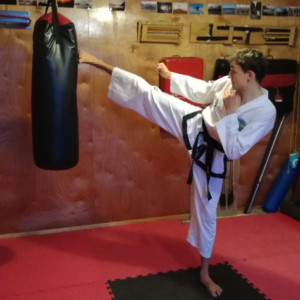
The humble turning kick, dollyo chagi is one of the first kicks you learned way back at yellow stripe (9th gup). Then when you graded to yellow belt (8th gup) you encountered the side turning kick, yop dollyo chagi. Take a moment now, before you read on, to explain the difference to yourself. Ooh, and is there such a thing as a front turning kick?
A turning kick (dollyo chagi) has the target, the opponent, to your side front. The side front is approximately in front of your outside shoulder line. Consider Hwa-Rang Tul movements 18 and 19. These are high turning kicks in fast motion to the side front. At the moment of impact the toes on the stationary foot should point 45 degrees outward. The kicker has their shoulder, hips and foot forming a vee-shape (looking from above, a birds-eye-view).
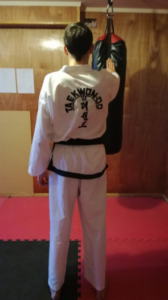
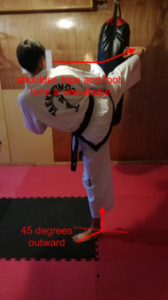
Turning Kick (normal) measure to side front and kick
A side turning kick (yop dollyo chagi) has the target, the opponent, standing abreast or in front of you. If the opponent is directly in front of you to begin with, you need to reposition to the side (step, slide, dodge or jump) to execute the side turning kick. Alternatively, you could spin around so you become perpendicular to the target and kick the target’s head with a side turning kick. At the moment of impact the toes on the stationary foot should point 75 degrees outward. The kicker has their shoulder, hips and foot form a line when viewed from the left side in the middle photo below (or when looking from above, a birds-eye-view).
The opponent is being approached from the side (you are kicking from the side) hence the turning kick is a “side turning kick”. In this position the opponent presents a range of targets for example, the solar plexus, head, and the rib cage.
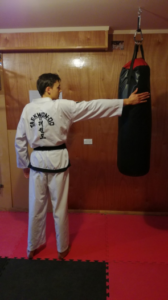
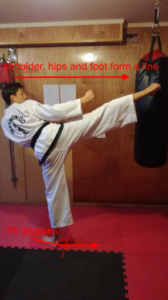
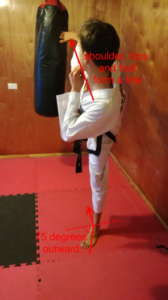
Side Turning Kick measure and kicks
Is there such a thing as a front turning kick? If the normal turning kick is to the side front (approximately to the outside of the shoulder) then a front turning kick, if there was such a thing, would have its target to the opponent’s solar plexus line (centre line) directly in front of you. You could more easily miss the target altogether – which is why we do not have a “front turning kick”. It would be better to reposition and execute a normal turning kick to the side front or execute a side turning kick to the head instead by spinning perpendicular to the target and kicking side on.
| Turning Kicks in patterns (up to 2nd Dan) | |
| Hwa-Rang | Mov. 18 – High TK (side front); Mov. 19 – High TK (side front); |
| Choong-Moo | Mov. 14 – High TK (side front); Mov. 17 – Middle TK (this is the only TK to the 45°); |
| Ge-Baek | Mov. 22 – Middle TK (side front); Mov. 33 – Middle TK (solar plexus); |
| Choong-Jang | Mov. 12 – High TK from the ground; |
Note the turning kick in Choong-Moo #17 is the only turning kick in our patterns whose target is to the 45 degrees of the attacker.


Turning Kick (left) and Side Turning Kick (right)
Turning kick (dollyo chagi) Taken from Gen Choi Hong Hi’s Taekwon-Do condensed encyclopaedia 5th Edition, p268
The turning kick is ideal for attacking an opponent positioned at the side front, and is usually performed with ball of foot, instep and knee, however the toes can be used as well if wearing shoes. The turning kick mist be executed from a suitable position, and if the position is awkward for this kick, the attacker must swiftly move into a suitable position.1. The hip must be swung forward to enable the foot to reach the target in an arc.2. The ball of foot must be vertical to the target at the moment of impact.3. The foot must have reached the apex of the kick shortly before contact so the toes are pointed slightly downward at the instant of contact.4. The toes of the stationary foot should point 45 degrees outward at the moment of impact.5. The kicking leg must not be bent more than absolutely necessary at the moment of impact.6. Do not attempt to kick the target positioned at the direct front.7. The arms must be kept within sight while kicking. |
Side turning kick (yop dollyo chagi) Taken from Gen Choi Hong Hi’s Taekwon-Do condensed encyclopaedia 5th Edition, p271
This is a variation of a turning kick. One of the advantages is the ability to attack the opponent standing abreast or in front. The ball of the foot and instep are the attacking tools. The toes of the stationary foot should point about 75 degrees outward while the kicking leg is kept straight at the moment of impact. It is also divided into low, middle and high side turning kicks. |
Pete Cossey, 2nd Dan, Hwa-Rang Taekwon-Do
